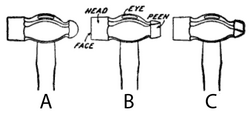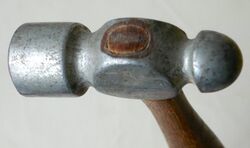Engineering:Ball-peen hammer
A ball-peen or ball pein hammer, also known as a machinist's hammer,[1] is a type of peening hammer used in metalworking. It has two heads, one flat and the other, called the peen, rounded. It is distinguished from a cross-peen hammer, diagonal-peen hammer, point-peen hammer, or chisel-peen hammer by having a hemispherical peen.
Uses
Besides for peening (surface hardening by impact), the ball-peen hammer is useful for many tasks, such as striking punches and chisels (usually performed with the flat face of the hammer). The peening face is useful for rounding off edges of metal pins and fasteners, such as rivets. The ball face of the hammer can also be used to make gaskets for mating surfaces. A suitable gasket material is held over the surface where a corresponding gasket is desired, and the operator will lightly tap around the edges of the mating surface to perforate the gasket material.[2]
Variants
Variants include the straight-peen, diagonal-peen, and cross-peen hammer. These hammers have a wedge-shaped head instead of a ball-shaped head. This wedge shape spreads the metal perpendicular to the edge of the head. The straight-peen hammer has the wedge oriented parallel to the hammer's handle, while the cross-peen hammer's wedge is oriented perpendicular. The diagonal-peen hammer's head, as the name implies, is at a 45° angle from the handle. They are commonly used by blacksmiths during the forging process to deliver blows for forging or to strike other forging tools.
Head materials
Ball-peen hammer heads are typically made of heat treated forged high-carbon steel[3] or alloy steel; it is harder than the face of a claw hammer.[4] Softer brass heads are sometimes used.
Notes
- ↑ Audel, Theodore (1962). Audels new mechanical dictionary for technical trades. Theodore Audel. p. 54. https://books.google.com/books?id=L2LVAAAAMAAJ&pg=PA54.
- ↑ Iniguez, Ramon C.. "Lesson Planner: How to make a gasket using a ball-peen hammer". CTE Online. California Department of Education. https://www.cteonline.org/curriculum/lessonplan/how-to-make-a-gasket-using-a-ball-peen-hammer-updated-by-ramon-c-iniguez/d2jo59.
- ↑ Cavette, Chris, How hammer is made, http://www.madehow.com/Volume-4/Hammer.html, retrieved 2008-12-19
- ↑ Benford 2006, p. 36
References
- Benford, Tom (2006). Garage and Workshop Gear Guide. MotorBooks/MBI. ISBN 0-7603-2312-7. https://archive.org/details/garageworkshopge0000benf.
 |




